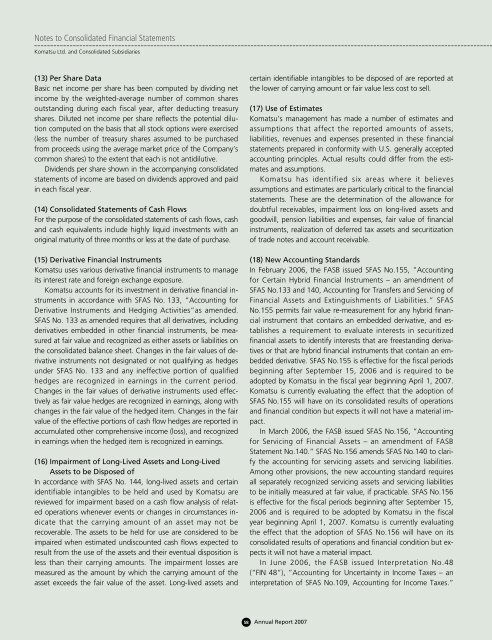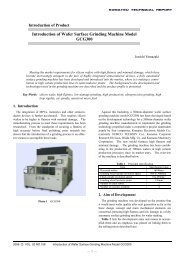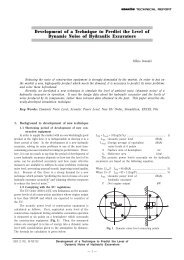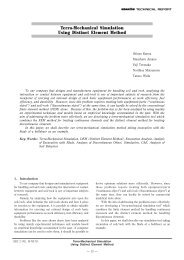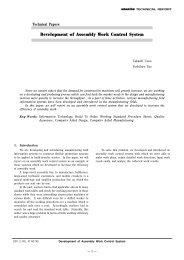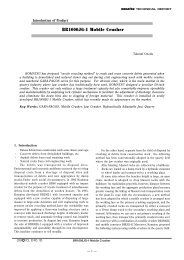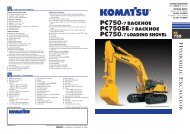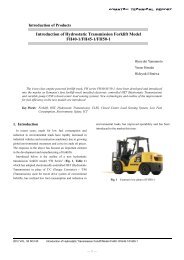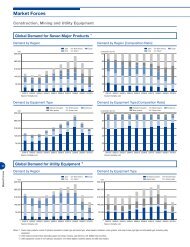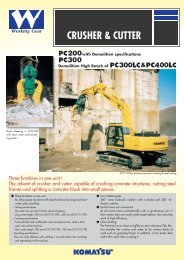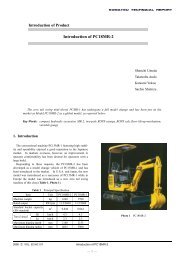Annual Report 2007 - Komatsu
Annual Report 2007 - Komatsu
Annual Report 2007 - Komatsu
You also want an ePaper? Increase the reach of your titles
YUMPU automatically turns print PDFs into web optimized ePapers that Google loves.
Notes to Consolidated Financial Statements<br />
<strong>Komatsu</strong> Ltd. and Consolidated Subsidiaries<br />
(13) Per Share Data<br />
Basic net income per share has been computed by dividing net<br />
income by the weighted-average number of common shares<br />
outstanding during each fiscal year, after deducting treasury<br />
shares. Diluted net income per share reflects the potential dilution<br />
computed on the basis that all stock options were exercised<br />
(less the number of treasury shares assumed to be purchased<br />
from proceeds using the average market price of the Company’s<br />
common shares) to the extent that each is not antidilutive.<br />
Dividends per share shown in the accompanying consolidated<br />
statements of income are based on dividends approved and paid<br />
in each fiscal year.<br />
(14) Consolidated Statements of Cash Flows<br />
For the purpose of the consolidated statements of cash flows, cash<br />
and cash equivalents include highly liquid investments with an<br />
original maturity of three months or less at the date of purchase.<br />
(15) Derivative Financial Instruments<br />
<strong>Komatsu</strong> uses various derivative financial instruments to manage<br />
its interest rate and foreign exchange exposure.<br />
<strong>Komatsu</strong> accounts for its investment in derivative financial instruments<br />
in accordance with SFAS No. 133, “Accounting for<br />
Derivative Instruments and Hedging Activities”as amended.<br />
SFAS No. 133 as amended requires that all derivatives, including<br />
derivatives embedded in other financial instruments, be measured<br />
at fair value and recognized as either assets or liabilities on<br />
the consolidated balance sheet. Changes in the fair values of derivative<br />
instruments not designated or not qualifying as hedges<br />
under SFAS No. 133 and any ineffective portion of qualified<br />
hedges are recognized in earnings in the current period.<br />
Changes in the fair values of derivative instruments used effectively<br />
as fair value hedges are recognized in earnings, along with<br />
changes in the fair value of the hedged item. Changes in the fair<br />
value of the effective portions of cash flow hedges are reported in<br />
accumulated other comprehensive income (loss), and recognized<br />
in earnings when the hedged item is recognized in earnings.<br />
(16) Impairment of Long-Lived Assets and Long-Lived<br />
Assets to be Disposed of<br />
In accordance with SFAS No. 144, long-lived assets and certain<br />
identifiable intangibles to be held and used by <strong>Komatsu</strong> are<br />
reviewed for impairment based on a cash flow analysis of related<br />
operations whenever events or changes in circumstances indicate<br />
that the carrying amount of an asset may not be<br />
recoverable. The assets to be held for use are considered to be<br />
impaired when estimated undiscounted cash flows expected to<br />
result from the use of the assets and their eventual disposition is<br />
less than their carrying amounts. The impairment losses are<br />
measured as the amount by which the carrying amount of the<br />
asset exceeds the fair value of the asset. Long-lived assets and<br />
certain identifiable intangibles to be disposed of are reported at<br />
the lower of carrying amount or fair value less cost to sell.<br />
(17) Use of Estimates<br />
<strong>Komatsu</strong>’s management has made a number of estimates and<br />
assumptions that affect the reported amounts of assets,<br />
liabilities, revenues and expenses presented in these financial<br />
statements prepared in conformity with U.S. generally accepted<br />
accounting principles. Actual results could differ from the estimates<br />
and assumptions.<br />
<strong>Komatsu</strong> has identified six areas where it believes<br />
assumptions and estimates are particularly critical to the financial<br />
statements. These are the determination of the allowance for<br />
doubtful receivables, impairment loss on long-lived assets and<br />
goodwill, pension liabilities and expenses, fair value of financial<br />
instruments, realization of deferred tax assets and securitization<br />
of trade notes and account receivable.<br />
(18) New Accounting Standards<br />
In February 2006, the FASB issued SFAS No.155, ”Accounting<br />
for Certain Hybrid Financial Instruments – an amendment of<br />
SFAS No.133 and 140, Accounting for Transfers and Servicing of<br />
Financial Assets and Extinguishments of Liabilities.” SFAS<br />
No.155 permits fair value re-measurement for any hybrid financial<br />
instrument that contains an embedded derivative, and establishes<br />
a requirement to evaluate interests in securitized<br />
financial assets to identify interests that are freestanding derivatives<br />
or that are hybrid financial instruments that contain an embedded<br />
derivative. SFAS No.155 is effective for the fiscal periods<br />
beginning after September 15, 2006 and is required to be<br />
adopted by <strong>Komatsu</strong> in the fiscal year beginning April 1, <strong>2007</strong>.<br />
<strong>Komatsu</strong> is currently evaluating the effect that the adoption of<br />
SFAS No.155 will have on its consolidated results of operations<br />
and financial condition but expects it will not have a material impact.<br />
In March 2006, the FASB issued SFAS No.156, ”Accounting<br />
for Servicing of Financial Assets – an amendment of FASB<br />
Statement No.140.” SFAS No.156 amends SFAS No.140 to clarify<br />
the accounting for servicing assets and servicing liabilities.<br />
Among other provisions, the new accounting standard requires<br />
all separately recognized servicing assets and servicing liabilities<br />
to be initially measured at fair value, if practicable. SFAS No.156<br />
is effective for the fiscal periods beginning after September 15,<br />
2006 and is required to be adopted by <strong>Komatsu</strong> in the fiscal<br />
year beginning April 1, <strong>2007</strong>. <strong>Komatsu</strong> is currently evaluating<br />
the effect that the adoption of SFAS No.156 will have on its<br />
consolidated results of operations and financial condition but expects<br />
it will not have a material impact.<br />
In June 2006, the FASB issued Interpretation No.48<br />
(“FIN 48”), ”Accounting for Uncertainty in Income Taxes – an<br />
interpretation of SFAS No.109, Accounting for Income Taxes.”<br />
58 <strong>Annual</strong> <strong>Report</strong> <strong>2007</strong>


